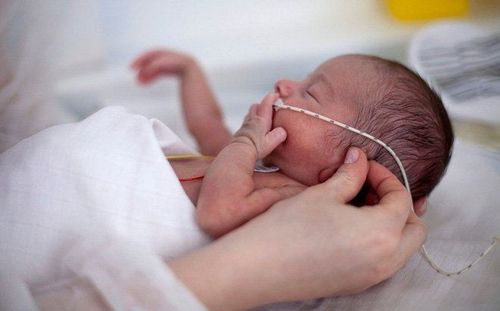This is an automatically translated article.
Infants lying in the hammock incorrectly can cause the spine to be affected by the shape of the hammock. Therefore, to prevent this situation, parents need to put their children in a hammock properly.
1. Should babies sleep in hammocks or not?
There are 2 reports by researchers at the University of Auckland, New Zealand, who conducted an examination to see if babies sleeping in a hammock affect the amount of oxygen that babies receive during sleep. Because children at this age have a very high risk of death. Research results show that the position of the child sleeping in a hammock does not affect the upper respiratory system of the child while sleeping, the time the child sleeps in the hammock is also not clearly shown, so it is not possible to confirm that the child sleeps on the hammock. better sleep cycle. However, the findings in this study do not apply to all types of hammocks and also depend on the age of the child.
To answer the question "is it good for children to sleep in a hammock", parents need to know the advantages and disadvantages of letting children sleep in a hammock.
2. Advantages and disadvantages of letting children sleep in a hammock
Newborns sleeping in a hammock will feel safe and fully wrapped because the hammock can hug the whole body. When the child feels more secure, it also avoids the child's startling situation. Moreover, the gentle movement of the hammock also helps the baby feel as soft as lying in the mother's womb, making the baby feel secure and sleep better.
Besides the above advantages, the use of rings can bring some disadvantages.
Children will be prone to shaking syndrome: This syndrome often occurs in children under 24 months, causing serious consequences when children grow up and can be compared with this level of danger will be similar to that of adults. had an accident and suffered a traumatic brain injury. When shaking children, they may experience unpleasant sensations due to the frequency of vibrations being too strong in the hammock, negatively affecting the child's brain development, and may even cause the child to have dementia. epilepsy-related diseases. May cause adverse effects on the spine and rib cage: Infants lying in a hammock can cause the spine to be affected by the shape of the hammock. Because infants at this stage are forming bone structure, when children lie in a hammock a lot, it can cause curvature of the spine when the child grows up. In addition, children may also experience cases such as hunchback, flexed neck, bent body. Even in some children, there is a case of skull dents due to frequent hammock lying. Lying in a hammock can cause neurological inhibition in children, making the nervous organs feel tired, making them easy to feel afraid even when they have fallen into a deep sleep. If parents take the child out of the hammock while the child is sleeping, the child will startle and cry, these will have a negative impact on the child's brain. Children's motor nerves will be limited in development due to lying in a hammock: The main reason is due to the delay in neurological development. When children lie in a hammock for a long time, children will be restricted from performing activities such as crawling, crawling, and flipping. Moreover, constantly lying in a hammock can make it difficult for children to move their arms, legs, head and neck. These factors cause blood accumulation and cause limitations in brain development, affecting children's later cognition. Lying in a continuous circle can affect the muscles of the child: When the child is in a hammock, the activities of stretching and stretching the child's limbs are not comfortable, sometimes even difficult to perform. Limiting physical activities makes the child's ability to grow and expand muscle follicles as well as the ability to circulate blood in the body. Children can become dependent on the hammock because they are used to the swinging motion of the hammock: When a child has trouble falling asleep, swinging the hammock makes it easier for them to fall asleep. However, this long-term situation can make children dependent on hammocks, sometimes without a hammock, children cannot sleep. When the child is a little older, it is very difficult for parents to help the child re-learn the habit of sleeping without the swinging hammock. Lying in a hammock can put children at risk of falls and breathing difficulties. Newborn babies can sleep in a hammock, but when they get a little older, this is completely different. Babies at 3 months will often roll over or roll over, lying around can make it difficult for them to move and cause them to fall. In dangerous cases, the child can die because the child's breathing is blocked.

Cha mẹ cần cho trẻ nằm võng đúng cách
3. Let the child lie in the hammock properly
In order for the child to lie in a hammock properly, parents need to note a few points:
Make sure the child is always safe while sleeping. Particular attention is paid to factors that may reduce the risk of Sudden Infant Death Syndrome. Parents should put the infant in a hammock properly with the supine position, should not put the baby in the side or stomach position because it can negatively affect the baby's airway. To help children lie in a hammock properly, parents need to carefully check the hammock frame to see if it is capable of supporting the child or not. If parents use an old hammock, it may happen that the hammock is broken or cannot bear the weight of the child. Parents need to choose a safe and secure place to hang the hammock for their children. At the same time, regularly check the tightness of the lanyard. Because in the process of using the rope can loosen and cause the child to fall. Pillows, blocks or soft toys should not be used in the hammock while the child is sleeping, it can pose a risk of suffocation and also make the child feel hot. Do not hang any accessories in the children's hammock, such as colorful tassels or ribbons... Parents should choose hammocks with cool, easy-to-clean materials. Pay attention and warn older siblings not to swing the hammock or climb into the ring when a baby is inside. Parents regularly wash the hammock clean to limit dirt that can affect the child's skin or respiratory system. Newborns have sensitive skin, so they are prone to allergies or rashes,... if their utensils are not cleaned properly. Children should sleep in a hammock when they are 3 months or older and especially only use hammocks for daytime naps.

Cho trẻ sơ sinh nằm võng có ảnh hưởng đến cột sống
Please dial HOTLINE for more information or register for an appointment HERE. Download MyVinmec app to make appointments faster and to manage your bookings easily.













